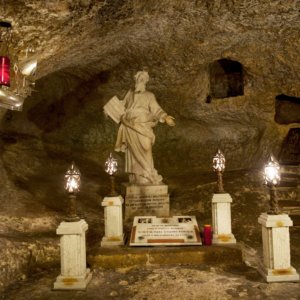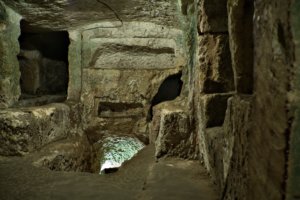A quaint recently refurbished museum found in the winding streets of Rabat is the Wignacourt Museum. Originally the abode of the chaplains of the Knights of St John it now houses a museum with a number of underground tombs in its bowels. The barque Wignacourt museum building was inaugurated in the early 1600s by Grand Master Alof de Wignacourt as a College. The latter, conscious of the popularity of the nearby pilgrimage site that is St Paul’s Grotto located beneath the Collegiate church of St Paul, and having just been entrusted with the management of the site, established the Wignacourt College as its trustee and patrons tasked specifically with promoting the Pauline cult.

St Paul’s Grotto Rabat
The building itself was fully completed in 1749. Standing on three levels it houses a number of different and interesting features that can keep you occupied for a good afternoon. The lowest level is home to a number of underground tombs, very common in this part of Rabat, and which date as far back as the Punic period (7th century B.C); these tombs were also used during the Roman period and by the early Christians of the island. Here one can admire the various types of tomb architecture used from the elaborate Baldacchino type to the more common loculi; even in death wealth can still define us! These hypogeal are linked to St Paul’s Grotto and also to around 50 underground World War 2 air raid shelters. The latter could house up to 350 people.

Catacombs
The actual museum starts on the ground floor. Although most of the rooms here are nowadays used mainly as offices, space is also dedicated to small collections. Upon entering the museum one also finds a lovely garden and a chapel built purposely for the exclusive use of the chaplains. Within this garden the chaplain’s refectory (a canteen for you and me) used to stand. An interesting fact to point out is the presence of an oven which, during World War 2, used to produce up to 2000 loaves daily for the consumption by the inhabitants of the area.
The majority of the exhibits displayed in the Wignacourt museum can be found on the top floor. Work of artists of the calibre of Mattia Preti, Francesco Zahra and Antoine Favray take pride of place. 100 years old reliquaries and relics, some of which personally sent to the Spanish hermit Fra Juan Beneguas de Cordova who settled for a while on the island in 1600 by Pope Paul V and Grand Master Aloph De Wignacourt, can still be admired. Other noteworthy exhibits, most of which coming from the private collection of notary Francesco Catania an important benefactor of the Collegiate, making part of this eclectic collection include: an 1833 manuscript map of the Maltese islands, a collection of coins spanning from the Roman period up to the Knights period, late 8th century BC pottery ware, antique silverware and a book authored by Henry the 8th entitled ‘Septem Sacramants” in which he challenges the views of Martin Luther.
Currently the Wignacourt museum is run by the church; however this was not always the case. Following the handing over of Malta from the Knights of Malta to the French the museum was administered by the government and along its administration the collegiate served as a school, an infirmary and as a parish and civic centre. In 1961, the College was given back to the church and 20 years later it was re-opened as a museum. The refurbishment project undertaken a couple of years ago have given this place and its contents a well deserved restorative touch, one worthy of being admired and visited.